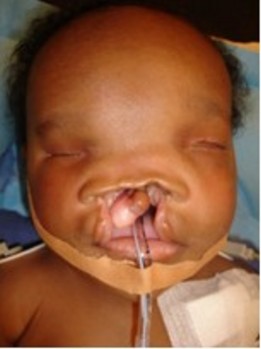(FND stands for FrontoNasal Dysplasia)
Very rare. Heterogeneous group of malformations (syndromic or not) involving a variable defect of the medial part of the face.
Diagnosis is based on the presence of at least two of the following features:
- ocular hypertelorism
- widening of the base of the nose
- wide philtrum
- median facial cleft that may affect the nose and/or upper lip and palate
- uni- or bilateral notch in the wings of the nose
- absence or hypoplasia of the nasal tip
- V-shaped (pointed) frontal hair implantation
- sometimes: ankyloglossia
Anterior cranium bifidum occultum [ MIM 168 500] is sometimes present: delayed ossification of the parietal bones results in a large medial bone defect; subcutaneous herniation of the meninges or brain is sometimes present.

Most cases are sporadic, but familial cases have been described.
A distinction is made between:
- FND1 or median facial cleft or frontorhynia: autosomal recessive transmission of a mutation of the ALX3 gene (1p13.3) [MIM 136 760]. Wide nasal root, median cleft lip or palate, tetralogy of Fallot, cranium bifidum occultum, microphthalmia, moderate to severe mental retardation, conduction deafness.
- FND2: autosomal recessive or dominant transmission of a mutation of the ALX4 gene (11p11) [MIM 613 451]. Hypertelorism, microcephaly, short palpebral clefts, notched nasal wings, bifid nose, wide columella, craniostenosis, intellectual retardation, sometimes alopecia.
- FND3: the most severe form: mutation of the ALX1 gene (12q21) [MIM 613 456]. Large facial cleft, bilateral microphthalmia, hypertelorism, absence of eyebrows and rare eyelashes, palate development disorders, moderate mental retardation, low-implanted ears.
Fronto-nasal dysplasia is sometimes syndromic and associated with other anomalies:
- acromelic fronto-nasal dysplasia or dysostosis [MIM 603 671]: mutation of the ZSWIM6 gene (5q12.1). Median facial cleft, bifid nose, hypertelorism, parietal defects, limb malformations (varus equinus clubfoot, polydactyly, tibial anomalies), cerebral malformations (agenesis of corpus callosum, periventricular heterotopia, hydrocephalus, interhemispheric lipoma), intellectual disability.
- fronto-facio-nasal dysplasia [MIM 229 400]: blepharophimosis and S-shaped palpebral clefts, palpebral coloboma, telecanthus, facial hypoplasia, pointed hair implantation, cranium bifidum occultum, frontal lipoma, nasal hypoplasia, bifid nose, cleft lip, premaxilla, palate and uvula.
- oculoauriculofrontonasal syndrome [MIM 601 452]: developmental anomalies of the first two branchial clefts (microtia, cleft lip/palate, auricular appendages, mandibular hypoplasia with facial asymmetry) associated with encephalocele, bifid nose and forehead anomalies.
- acrofrontofacial syndromes [MIM 201 180, 239 710]. Mental retardation, short stature, hypertelorism, broad nasal tip, cleft lip/palate, hypoplastic fibula, postaxial camptobrachypolysyndactyly, foot anomalies.
- craniofrontonasal syndrome [MIM 304 110]: X-linked transmission of a mutation of the EFNB1 gene (Xq13.1). The presentation is more severe in girls. Bifid nose or tip hypoplasia, hypertelorism, coronal craniosynostosis, split nails, clavicle anomalies, thick or woolly hair.
- oro-facio-digital syndrome type 1 (see this term)
- Nager syndrome (see this term)
Anesthetic implications:
check for any associated cerebral malformations or craniosynostosis; avoid nasal intubation; risk of difficult intubation
References :
- Umair M, Ahmad F, Bilal M, Arshad M.
Frontonasal dysplasia: a review.
Journal of Biochemical and Clinical Genetics 2018;1:2–14.
Updated: March 2024